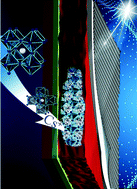Arranging strategies for A-site cations: impact on the stability and carrier migration of hybrid perovskite materials†
Abstract
Cesium (Cs)–formamidinium (FA)–methylammonium (MA) triple cation-based perovskite materials have led to the most efficient and stable perovskite solar cells reported. However, most studies focused on the relationship between crystal structure distortion and efficiency. Herein, the role of cations that have been neglected all the time is emphasized firstly in the nanoscale model by state-of-the-art simulation combining static, ab initio dynamic and nonadiabatic molecular dynamic simulations. Considering the influence of Cs sites, the structural robustness is confirmed and the structurally related stability is not very sensitive to the position of Cs cations. Upon heating at 298 K, Cs cations can suppress halide redistribution and phase separation. The detailed time-domain atomistic analysis of charge carrier dynamics indicates that the electron–hole recombination time of 5% Cs systems is slower as the values of nonadiabatic coupling are smaller (sub-1.5 meV) and the coherence time is shorter (sub-10 fs). These results promote the comprehensive understanding of the influence of cations on perovskite materials and pave the way to further increasing the efficiency of perovskite-enabled photovoltaic materials.



 Please wait while we load your content...
Please wait while we load your content...